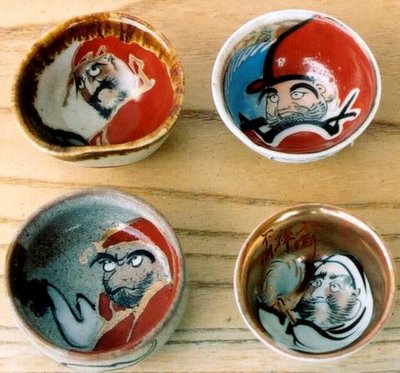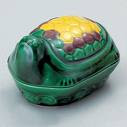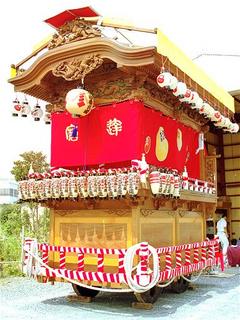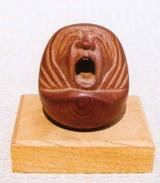:::::::::::::::::::::::::::::::::::::::::::::::::::::::::::::::::::::::::::::::::::::::::::::::::::::
Sakazuki, small cups to drink Sake
さかずき【杯/盃/坏】
choko, ochoko ちょく【猪口】

I have written extensively about
Tokkuri - Drinking Hot Sake with Daruma
徳利とだるま―焼物散歩
Sake and Shochu - Ricewine, Schnaps and Daruma
酒、焼酎と達磨 ...
My Photo Album about Sake and Daruma
:::::::::::::::::::::::::::::::::::::::::::::::::::::::::::::::::::::::::::::::::::::::::::::::::::::
Here is a nice pair made of wood and laquer. It starts of as one figure, and develops into a set of two cups with a small tray, almost like the maryoshika dolls of Russia.

Both heads are made flat so they stand as a sake cup.

Nr. 15 to 17 in the Album.
:::::::::::::::::::::::::::::::::::::::::::::::::::::::::::::::::::::::::::::::::::::::::::::::::::::
This piece is rather large, almost 25 cm.
I have written about a similar small one in the story about Takasago.
At first it looks like a small statue, then you take of the head and have the first sakazuki. Next comes O-Kame, off and used as a sakazuki for the wife.

Again, the heads are formed rather flat so the cups can stand.

Nr. 09 - 12 in the Album.
Read about
Meoto Daruma and Takasago - Daruma and a Happy Couple
:::::::::::::::::::::::::::::::::::::::::::::::::::::::::::::::::::::::::::::::::::::::::::::::::::::
Some sakazuki from Kutani

There are more in my Album, Nr. 18 to 21.
:::::::::::::::::::::::::::::::::::::::::::::::::::::::::::::::::::::::::::::::::::::::::::::::::::::
Tumbler with Daruma 達磨タンブラー

中国醸造
:::::::::::::::::::::::::::::::::::::::::::::::::::::::::::::::::::::::::::::::::::::::::::::::::::::

choko cups with a flask
:::::::::::::::::::::::::::::::::::::::::::::::::::::::::::::::::::::::::::::::::::::::::::::::::::::
SOME LINKS
The very small cups for ricewine are called sakazuki 杯.
Somewhat bigger versions are guinomi 食いのみ or o-choko.
. . . CLICK here for guinomi Photos !

In olden times flat vessles of earthware were called
hiraka ひらか【平瓮】
Books about Sake Vessels -
from www.e-yakimono.net, Robert Yellin
COMPLETE LISTING OF SERIAL SAKE STORIES
All Stories by Robert Yellin
... ... ... ...
Japanese Sake Containers - A bit on the KITSCH side.
:::::::::::::::::::::::::::::::::::::::::::::::::::::::::::::::::::::::::::::::::::::::::::::::::::::::::::::::::::::::::::

Japanese Military Sake Cups 1894-1945
This is the first book of its kind
regarding the up-and-coming hobby of collecting Japanese Military Sake Cups (guntai sakazuki). It consists of 144 pages of useful information and photos regarding the usage and history on Japanese Army & Navy sake cups used by the military for roughly 50 years. The book covers cups, sake bottles, sake trays and commemorative items. The cups photographed in the book are the result of the author's 20 years of collection WWII Japanese militaria with a focus on sake-related items.
The attraction of these cups is not only hand made, hand painted craftsmanship but their historical significance as well. Many cups will have the owner's regiment, name etc..on the cup which gives the collector the option of researching the cup to discover where the original owner was stationed during the war.
The Japanese military machine chose to revive several age-old samurai traditions including the use of hand-forged swords, long helmet straps tied in the samurai style, and the consumption of ceremonial sake before a battle.
The sake was consumed in a solumn ceremony, with no words spoken other than a reverent, singular "Kanpai" by the leader.
- other books by Dan King
The Last Zero Fighter
Firsthand Accounts from Japanese WWII Naval Pilots and Airmen
A Tomb Called Iwo Jima
Firsthand Accounts from Japanese Survivors
- source : Dan King
兵隊盃 / 従軍記念杯
- reference about these cups
:::::::::::::::::::::::::::::::::::::::::::::::::::::::::::::::::::::::::::::::::::::::::::::::::::::::::::::::::::::::::::
盃に 三つの名を飲む 今宵かな
sakazuki ni mitsu no na o nomu koyoi kana
with a sake cup
I drink to the three names
this fine evening
Matsuo Basho
Tr. Higginson
Where is the season word?—you ask? In the opening quatrain of
Li Po’s poem "Under the Moon, Drinking Alone":
Among the flowers one jug of wine:
drinking alone with no one familiar,
I offer my cup to the bright moon
my shadows and I a party of three.
Bashô, too, drinks alone, but has the companionship of "the three names": Li Po and his two shadows of the same name (one on the ground, one in the wine cup). Oseku points out that we should also note the puns in this hokku: Puns on "moon" (-zuki cup = tsuki moon) and "full" (mitsu three = mitsu to fill).5 Rather than provoking humor directly as a pun in English might, these implied words simply capitalize on the profusion of homonyms in Japanese to provide further clues to the poem’s hidden seasonal topic.
William Higginson, 2001
source : www.haijinx.com
la coupe de vin (la lune)
remplie de trois noms
pour boire ce soir
Tr. Daniel Py
On that night, there were three uninvited guests at Basho's home, all with the name of Shichirobei 七郎兵衛.
Basho had intended to drink alone in memory of Li Po, maybe, but the drunken visitors joined him.
This hokku has the cut marker KANA at the end of line 3.
. Li Po, Li Bo, Li Bai 李白, lived 701 – 762 .
.................................................................................
quote
Sakazuki ni / mitsu no na nomu / koyoi kana
With my sake cup
& the moon, I toast three friends —
this fine evening
Basho wrote this playful haiku in 1685, when three friends came to visit him late at night. He had in mind lines from Li Po’s poem:
With blossoms, a bottle of wine
Drinking all alone, no one else.
Raising the cup, we greet the bright moon
With my shadow we become three.
Basho substituted Li Po’s three friend, the wine cup, his shadow and the moon for three actual friends.
The influence of Chinese literature on Basho
Bill Wyatt
source : www.poetrymagazines.org.u
According to Wyatt, Basho's haiku was written in 1685, a time period that "the haikai world was swept by the "Chinese style" (kanshibun-cho)" .
(For further info. read the section titled "Parody and the Chinese Style" (Shirane,Haruo, Traces of Dreams: Landscape, Cultural Memory, and the Poetry of Basho, pp 60-7)
Basho was well-versed in Chinese classics. Read in the emotional context of his poem ("this fine evening"), "three friends" could be also read as an allusion to a popular Chinese idiom, three is a crowd, contrasted with Li Po's lonely lifeworld (himself, his shadow, and the moon).
Chen-ou Liu
Ricewine and sakazuki cups haiku by
. Matsuo Basho 松尾芭蕉 - Archives of the WKD .
.................................................................................
quote
Reviving Japanese Haikai Through Chinese Classics:
Yosa Buson and the Basho Revival
Li Po's poem Drinking Alone by Moonlight, the sixth in The Three Hundred Tang Poems
(月下獨酌, pinyin: Yuè Xià Dú Zhuó), translated by Arthur Waley, 1919, reads:
花間一壺酒。 A pot of wine, under the flowering trees;
獨酌無相親。 I drink alone, for no friend is near
舉杯邀明月。 raising my cup I beckon the bright moon,
對影成三人。 for her, together with my shadow, will make three people
"Three people" (or "a party of three;" Chinese: 三人) refers to the moon in the sky (, which connotates "Heaven"), Li Po's shadow on the ground ("Earth"),and Li Po himself ("Humanity").
Nankaku was a student of one of the most important Confucian scholars, Ogyu Sorai (1666--1728), who emphasized an unmediated understanding of Chinese classics, and whose thoughts had highly influenced the leading painters of nanga (also known as bunjinga, which literally means literati painting). Nanga was a school of Japanese painting modeled on the Chinese Southern school of painting, to which Buson belonged. Nankaku specialized in Chinese classics, and one of his greatest achievements was the Toshisen, a Japanese edition of one the most influential Chinese verse anthologies, Tang Selected Poems. The Toshisen had long served as one of the foundational texts for the bunjin movement.
The concept of “wenren” is highly related to that of “renwen” (wenren written inversely in Chinese). It can be found in the Yi Jing, also known as the Book of Changes, which is one of the oldest of Chinese classics. 36 Renwen can roughly be translated as meaning the "arts of humanity," one component of the three-fold Chinese universe: heaven, earth, and humanity. It "embodies all that is of the highest value to the society, and interacts with the other two: the spiritual and philosophical (tianwen) and the environmental and ecological (diwen). A person cultivated in renwen was originally called wenren.
source : Chen-ou Liu
Phenomenologically speaking, "three people" constitutes Li Po's lifeworld (German Lebenswelt understood in the Husserlian sense of the word).
Basho's allusion emotionally and tonally changes the connotative meaning of "three people."
Chen-ou Liu
. Chinese background of Japanese kigo .
koyoi no tsuki 今宵の月 the moon tonight
can be seen as a kigo for autum.
:::::::::::::::::::::::::::::::::::::::::::::::::::::::::::::::::::::::::::::::::::::::::::::::::::::
. Sake 酒 for rituals and festivals .
[ . BACK to WORLDKIGO TOP . ]
[ . BACK to DARUMA MUSEUM TOP . ]
:::::::::::::::::::::::::::::::::::::::::::::::::::::::::::::::::::::::::::::::::::::::::::::::::::::
















































